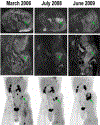18-fluorodeoxyglucose-positron emission tomography (FDG-PET) evaluation of nodular lesions in patients with Neurofibromatosis type 1 and plexiform neurofibromas (PN) or malignant peripheral nerve sheath tumors (MPNST)
- PMID: 22645095
- PMCID: PMC6626667
- DOI: 10.1002/pbc.24212
18-fluorodeoxyglucose-positron emission tomography (FDG-PET) evaluation of nodular lesions in patients with Neurofibromatosis type 1 and plexiform neurofibromas (PN) or malignant peripheral nerve sheath tumors (MPNST)
Abstract
Background: Individuals with Neurofibromatosis type 1 (NF1) are at risk for developing malignant peripheral nerve sheath tumors (MPNST), which frequently arise in preexisting plexiform neurofibromas (PN). Magnetic resonance imaging (MRI) with volumetric analysis and 18-fluorodeoxyglucose-positron emission tomography (FDG-PET) were utilized to monitor symptomatic nodular lesions.
Procedure: Patients with NF1 and PN on a NCI natural history trial were monitored for total body tumor volume (TTV) using volumetric MRI. FDG-PET was performed in individuals with a nodular well-demarcated lesion ≥3 cm if they were growing, painful, or there was a prior history of MPNST (target lesions). Asymptomatic nodular lesions were evaluated as non-target lesions.
Results: Fifteen patients (8m, 7f) median age of 18.3 years (range, 10-45 years) had a single target and non-target (n = 46) nodular lesions identified on MRI. Target lesions arose within (n = 8) or outside (n = 3) a PN, and all but 1 had increased FDG uptake. FDG uptake was increased in non-target lesions but to a lesser degree. FDG uptake in the surrounding PN was low, similar to background activity. Pathologic evaluation performed in 11 patients demonstrated neurofibroma (n = 6), atypical neurofibroma (n = 2) and malignancy (n = 3).
Conclusions: Nodular target lesions identified on MRI in individuals with NF1 and PN demonstrate increased FDG uptake similar to MPNST, but may be benign on biopsy. Nodular target lesions may be at greater risk for malignant transformation, but their biologic and clinical behavior has not been well studied. Careful longitudinal evaluation will be required to better understand the malignant potential of these lesions.
Copyright © 2012 Wiley Periodicals, Inc.
Conflict of interest statement
Conflicts of interest: Nothing to declare.
Figures




References
-
- Korf BR. Diagnosis and management of neurofibromatosis type 1. Curr Neurol Neurosci Rep 2001;1:162–167. - PubMed
-
- Friedman JM. Neurofibromatosis 1: Clinical manifestations and diagnostic criteria. J Child Neurol 2002;17:548–554; discussion 571–542, 646–551. - PubMed
-
- Korf BR. Plexiform neurofibromas. Am J Med Genet 1999;89:31–37. - PubMed
-
- Mautner VF, Hartmann M, Kluwe L, et al. MRI growth patterns of plexiform neurofibromas in patients with neurofibromatosis type 1. Neuroradiology 2006;48:160–165. - PubMed
-
- Friedrich RE, Korf B, Funsterer C, et al. Growth type of plexiform neurofibromas in NF1 determined on magnetic resonance images. Anticancer Res 2003;23:949–952. - PubMed
MeSH terms
Substances
Grants and funding
LinkOut - more resources
Full Text Sources
Medical
Research Materials
Miscellaneous

